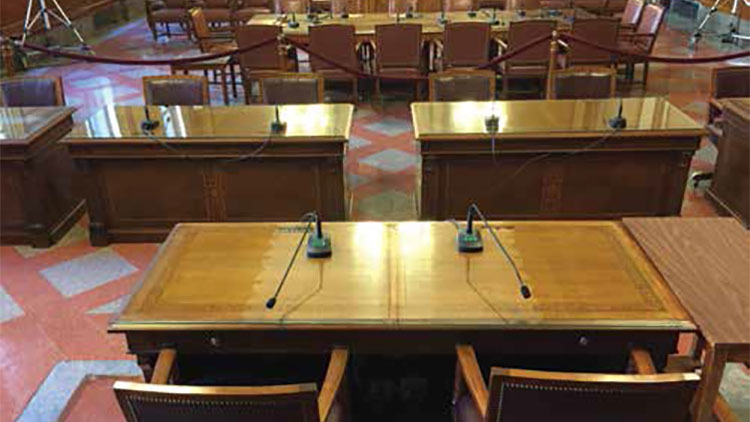Pittsburgh Renovates Historic Municipal Building With New Tech

In 1916 Pittsburgh, PA celebrated the 100th anniversary of its incorporation as a city with the commissioning of a new seat for its government, the Pittsburgh City-County Building, which occupies an entire city block. This year, as the city celebrates its bicentennial, the building has just undergone a major renovation of its government access channel infrastructure, featuring an AV design by RPC Video that includes major components from Audio-Technica, Biamp, Leightronix, Panasonic, Scale Logic, and Soundcraft.

In the chamber, there are a total of 27 Audio-Technica ES915C18 cardioid pattern goosenecks, 22 on Danteenabled desktop bases, and the remainder of through-desk AT8474 shock mounts. “This project was 30-plus years in the making,” said David Finer, who was promoted to the position of communication technology manager at the City of Pittsburgh’s Department of Innovation and Performance in November 2014. “We’ve made a huge leap in the last 18 months, skipping, by my count, at least two generations of video technology. Even at the beginning of 2013 we were still recording on videotape. Now that the renovation is done, we are up to 2016 standards.”
Finer, who has worked in public, governmental, and educational access television since 1993, initially met with RPC Video’s Steve Obenreder, sales manager, and Matthew Bernardini, field engineer, at the start of 2015. “I explained what I was looking for, and then we met about a dozen times more, going through the equipment list, item by item,” he said.
The project got off to a slow start, identifying and testing 30-plus years of cabling. “Any time new cabling had been put in, they never removed the previous technology. So it was a slow task, going through every cable.”
The task was to renovate the in-house broadcast, streaming, and archiving production systems and infrastructure for City Channel Pittsburgh, which is available live via Comcast and Verizon and the city’s website, and on-demand on its YouTube channel. The AV signal and data transport infrastructure, which had been analog, was replaced by 64 strands of single-mode fiber. The networks connect production and engineering facilities on the ninth floor with the city council chamber on the fifth floor. Additionally, four seats of Adobe Premiere edit stations on the sixth floor can access content stored on a new 96TB Scale Logic Genesis RX SAN.
“The Dante network stands alone on its own fiber strands, as does the camera control network, and then we have a third network for data and everything else,” explained Bernardini, who used a third-party contractor to deploy the fiber. “We may eventually merge them onto different VLANs, but right now they are isolated networks.”
In fact, there are separate Dante networks, said Bernardini—one for sound reinforcement in the chamber and a second for the video production system that televises sessions by the legislative body. Audio input and output to and from the Dante networks is via Biamp Tesira Server IO units in the chamber and in Control Room A, with backup devices in the engineering department and in the control room. Tesira’s AVB network support is also employed to interconnect several Biamp Ex-Mod I/O expanders.
A daily selection of the top stories for AV integrators, resellers and consultants. Sign up below.
The old XLR-connected microphones in the chamber were replaced with a total of 27 Audio-Technica ES915C18 cardioid pattern goosenecks, 22 on Dante-enabled desktop bases and the remainder of through-desk AT8474 shock mounts (included with ES915C18), plus a single ATU857QLU UniLine Condenser Quick-Mount gooseneck mic. “We’ve been Audio-Technica dealers for a few years,” said Obenreder. “When we were starting to do this, we didn’t look around. Based on what we’d done with A-T before, and the Dante microphone bases that they have, I just knew it was going to work fine.”
Sound reinforcement in the chamber is delivered through a pair of Innovox HLA-9XT nine-element J-arrays, powered by QSC PLD 4.5 amplifiers, although Bernardini originally specified more zones and channels. “It’s a live enough space, and there’s enough reverberation that trying to introduce more origination points for the signal complicated it,” he said.
Bernardini programmed the Tesira DSP to keep a check on potential feedback: “It wouldn’t have been possible without line arrays. Plus, we used gain-sharing mixers for different speaker zones and added very subtle gating to fine-tune it.”
Remote-controlled Panasonic AW-HE130 pan-tilt-zoom HD cameras have replaced the previous human-operated systems. Video is handled by a Ross Carbonite switcher purchased during an earlier renovation, newly upgraded to 24 inputs. A new Leightronix UltraNEXUS HD playout server has replaced the previous setup.
Audio from the chamber is transported over Dante to a 32-channel Soundcraft Si Performer 3 in the control room. “The Soundcraft mixer has one RJ45, and that’s exactly how I wanted it,” laughed Bernardini.
The equipment upgrades are welcome, but Finer is happier that the new production space, created out of two previous rooms, offers a better work environment. “The old spaces were really cramped; people were reaching across each other. I’ve worked in some really awful control rooms, and the one we previously worked in was the worst by far. Now I’m working in the best. I think that’s the biggest difference.”
